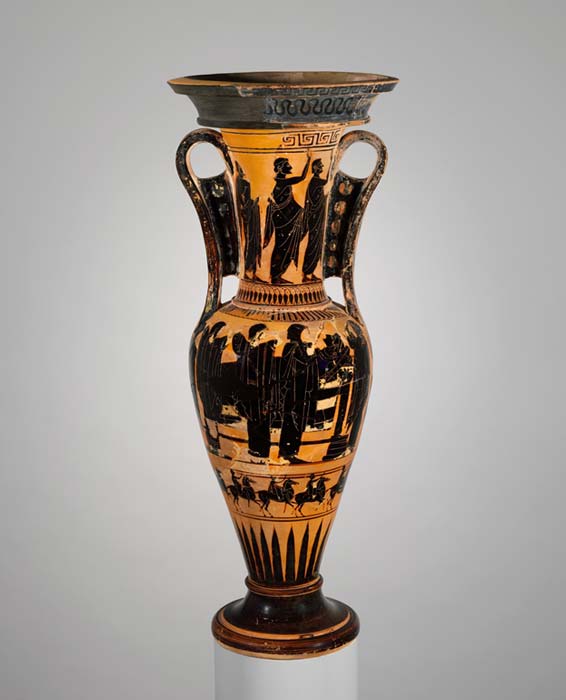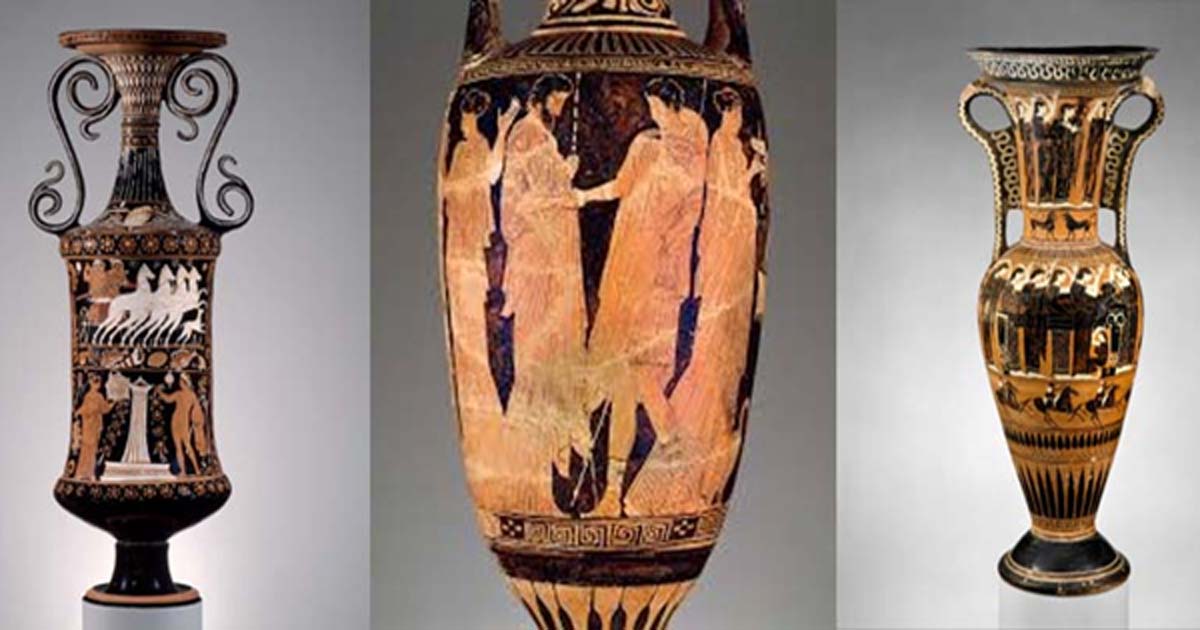From Cremated Ashes to Holy Water for a Bride’s Ritual Bath, The Loutrophoros Was No Ordinary Vase
A loutrophoros is a distinctive type of Greek pottery characterized by an elongated neck with two handles. It is a specific type of amphora, which was a type of Greek container used as early as the Neolithic Period. These amphorae were used to transport and store various liquids, dry goods, and sometimes the ashes of the deceased. However, the vessel was much more than just an ordinary vase to the Greeks. In English “loutrophoros” can be translated as “bathwater,” from loutron, and “carry,” from phero; as such, it was used to carry water for a bride’s prenuptial ritual bath. It was also used in funerary rituals and as place markers for the graves of the unwed. Examples of this vessel, either as artifacts themselves or examples in art, date back as early as the 8 th century BC, but by the Roman period this type of amphora was largely phased out.
- Russian scientists use a mass spectrometer to look inside an ancient Greek amphora
- Dozens of Shipwrecks Dating Back Thousands of Years Found in the Aegean Sea
- 600 Kilos of 4th Century Roman Bronze Coins Discovered in Spain
A Symbolic Grave Marker
From the surviving literary record, it can be concluded that, in the classical period, the term “loutrophoros” referred to a person who carried the water for a ritual bath, especially for a bride or groom before their wedding. From this, a loutrophoros would stand symbolically as a grave-marker for those that had died prematurely and were unwed. However, this is a complicated matter in the archaeological evidence as there are no persons seen carrying a water jug in the classical funerary monuments. The alternative conclusion is that, at some point, the significance of the word transferred from person to object and the vessel became the symbolic grave marker. This can be seen in the archaeological record, and later in the surviving lexical record. It has been suggested that the term referred to the person in antiquity and was only given to the vessel in more modern times.

Analatos Painter: Couples dancing to the sound of the aulos. Neck of a proto-Attic loutrophoros. (CC BY NC-SA 2.0)
A 2,600-Year-Old Style
The loutrophoros was a very tall vessel with a funnel-shaped neck, set on a slender, elongated body. Sometimes there was a foot at the bottom, other times there was no bottom at all. The handles reach from the shoulder to just below the lip, forming a large loop that was sometimes open and sometimes filled in. This vessel can also appear in the form of a hydria with a third handle reaching from the shoulder to the lip. This style harkens back to the amphorae of the Late Geometric Period as well as Early Attic vases. From this, the shape continues from the late 6 th century BC to the late 4 th century BC. As time progressed, the vessel became more elongated and spindly. In the early black-figure, ca. 7 th century BC, the loutrophoros was reserved for funerary purposes, used mainly as a grave marker. In the 5 th century BC the vessel starts to be used for ritual purposes like weddings or funerals. As such, the vessels are usually decorated with scenes of mourners or wedding processions depending on its use.
While the loutrophoros was used for both weddings and funerals, it is unclear which was the primary purpose. One theory suggests that the use in funerals was secondary, and arose from the primary function in wedding rituals. In this way, as a grave marker, the deceased was given a post-mortem symbol of marriage. However, the opposing argument points to loutrophoroi being placed on graves from very early on, until the 5 th century when they started to be replaced by a more durable monument of stone. Similarly, the earlier vessels depict funerary themes, such as the prosthesis, or “laying out of the body,” which was a funerary ritual. It wasn’t until later that the vessels started to depict marriage scenes.

Terracotta loutrophoros depicting body in prosthesis, 6 th century BC, Greek. Met Museum (Public Domain)
The Funerary Role
One archaic example of a loutrophoros, from the late 6 th century BC, can be found at the Metropolitan Museum. This specific vessel is made from terracotta and was extensively decorated with funerary scenes. On the shoulder of the vase a youth lays on a couch in prothesis, surrounded by grieving women. These women are shown with short hair and hands held high signifying the pulling out of their own hair in grief. Their open mouths match those of the mourning men on the reverse showing that they are all singing funeral songs. On the neck, another group of mourning women can be seen, one holding a loutrophoros. Below, horse men raise their hands and tear out their hair in lamentation. It is the presence of these scenes of mourning, along with the lack of a bottom, that lead scholars to believe that this loutrophoros was used as a grave maker. The vessel would have been made without a bottom so that onlookers and mourners could pour libations into the vessel and they would eventually reach the deceased.
- 2,500-Year-Old Skeleton is Oldest Known Remains of a Panathenaic Athlete
- The Ancient Greek Symposium: Just an Excuse for Debauchery?
- A Greek Town in Catalonia: What Fantastic Secrets are Still Hidden in Empúries?

Bathing vessel (loutrophoros) depicting a bridal procession (Museum of Fine Arts)
Wedding Processions
Another example, this time from the 5 th century BC, shows the loutrophoros’ use as part of a wedding, as opposed to a funeral. This particular vessel can be found at the Museum of Fine Arts in Boston, and it depicts a bridal procession. On the front, a young man takes his bride by the hand and leads her into his house. Two erotes (winged gods associated with Aphrodite and Eros) fly overhead. Behind the bride, fixing her veil, stands a nympherutria, the supervisor of a wedding. In the doorway of the home stands the groom’s mother holding two torches, and other female figures fill out the scene. On the other side, a young man is seen shaking hands with an older man, presumably the father of the bride. They shake hands in agreement concerning the engagement.

Full scene presented on bathing vessel depicting a bridal procession (Museum of Fine Arts)
The art found on these examples show the two distinct uses of the loutrophoroi. As such, showing that the funerary uses came first, and it wasn’t until later that the vessel came to be used in wedding processions.
Top image: Loutrophorai: Greek, Attica, c.440BC, (Penn Valley); Greek, Classical Period, 450–425 BC (MFA);Greek, South Italian, Early Hellenistic Period c.320–310 BC (MFA)
Resources
Classical Art Research Centre. 2012. Loutrophoros. [Online] Available at: http://www.beazley.ox.ac.uk/tools/pottery/shapes/loutrophoros.htm
Herford. Mary, A. B. 2009. A Handbook of Greek Vase Painting. [Online] Available at: https://books.google.ca/books?id=Ux28AAAAIAAJ&lpg=PA37-IA1&ots=dEob9a_DxI&dq=loutrophoros%20uses&pg=PP1#v=onepage&q=loutrophoros%20uses&f=false
Perseus Encyclopedia. Loutrophoros. [Online] Available at: http://www.perseus.tufts.edu/hopper/text?doc=Perseus:text:1999.04.0004:id=loutrophoros
Pritchard, David M. 2010. War, Democracy and Culture in Classical Athens. [Online] Available at: https://books.google.ca/books?id=qlDNl2JCwyQC&lpg=PA270&ots=Wydea48y7m&dq=loutrophoros%20uses&pg=PR3#v=onepage&q=loutrophoros%20uses&f=true
The Metropolitan Museum. Terracotta Loutrophoros. [Online] Available at: http://www.metmuseum.org/art/collection/search/252948
The Museum of Fine Arts. Bathing Vessel (Loutrophoros). [Online] Available at: http://www.mfa.org/collections/object/bathing-vessel-loutrophoros-depicting-a-bridal-procession-153797




















Comments
I NOTICED THAT THE VASES DID NOT HAVE STRAIGHT BLOND HAIRED WHITE PEOPLE PAINTED ON THEM TO REPRESENT PRESENT DAY WHITE EUROPEANS. INSTEAD, THE VASES MOSTLY SHOW THICK "WOOLLY DARK HAIRED" PEOPLE WHOSE HAIR RESEMBLED WOOLLY AFRO HAIR, AND SKIN TONES RANGING FROM LIGHT TO "black". I FIND THAT FACT TO BE VERY INTERESTING, WHICH MEAN THAT ANCIENT GREEKS DID NOT RESEMBLE WHAT WE CALL PRESENT DAY WHITE PEOPLE AT ALL. I GUESS THAT THOSE OLD GREEK MOVIES WITH ALL THOSE BLOND HAIR, BLUE EYED PEOPLE ARE JUST AN IMAGINATION OF WHAT WHITE PEOPLE WANT ANCIENT GREEKS TO LOOK LIKE, INSTEAD OF LOOKING LIKE GARAMANTES, PELASGIANS, ETC WHO CAME FROM WESTERN AND NORTHERN AFRICA ACCORDING TO ANCIENT GREEK HISTORIANS SUCH AS HERODOTUS, AND DIODORUS SICULUS, AS WELL AS MANY OTHERS.…."WOOLLY HAIRED AFRO STYLING ANCIENT GREEK PEOPLE"....
Charles Bowles